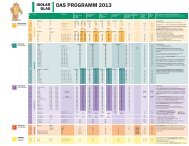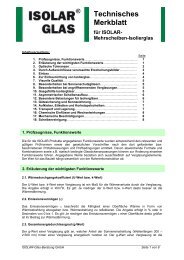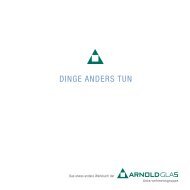Create successful ePaper yourself
Turn your PDF publications into a flip-book with our unique Google optimized e-Paper software.
ENGLISH<br />
COLOR – THE KEY TO OUR SENSES<br />
Have you ever thought about how color influences<br />
our moods? Everyone enjoys the sight of a crystal<br />
clear, blue sky on a beautiful sunny day. We often<br />
say that green is a symbol of hope and we are<br />
thrilled to see nature replace our grey or snowy<br />
white winter days in the spring with a thousand<br />
shades of green. Similarly the colors of our clothes<br />
also tell a story about us, as well as the colors we<br />
use in our surroundings – although a clear color<br />
scheme is often missing in many rooms.<br />
Admittedly, white can be chic. But it is not really a<br />
color that promotes a sense of comfort. For most<br />
of us, we want our surroundings to project a genuine<br />
feeling of wellbeing, security or even inspiration<br />
– and that is exactly why Sanalux glass can<br />
enhance virtually every interior. Sanalux, “The<br />
Comfort <strong>Glas</strong>s,” always projects a feeling of wellbeing,<br />
and just like its name it stands for health<br />
(Sana) and light (Lux).<br />
The positive effect of colored glass directly influences<br />
our visual senses. In fact, 80 to 90 % of the<br />
information we receive is visual. And colors there-<br />
fore play a major role. In combination with the form<br />
of an object, colors are key optical elements which<br />
help us to differentiate and categorize everything<br />
we see.<br />
Colors however, do more than just affect our eyes<br />
– colors strongly influence our moods or unconscious<br />
behavior. In a sense, colors have their own<br />
special energy which can also be transferred to a<br />
person’s attitude and feelings. For example, colors<br />
can be used therapeutically to promote a healing<br />
process or they can stimulate our sense of fantasy,<br />
creativity or performance. In brief: the colors we<br />
see directly affect our feeling of wellbeing.<br />
That is why color played such an important part in<br />
the development of Sanalux glass together with<br />
the support of color experts and interior designers.<br />
All together, twelve attractive color tones are now<br />
available – ranging from delicate light blue to powerful<br />
red. As a result, the owners of homes or buildings,<br />
construction planers and architects can now<br />
turn their visions into reality.<br />
Colors are the smiles of nature.<br />
JAMES HENRY LEIGH HUNT<br />
GLASS ELEMENTS FOR AN INSPIRING INTERIOR DESIGN<br />
Colors provide us with more than just optical stimulation,<br />
they affect our entire nervous system<br />
and body. For example: while blue can relax a<br />
rapid heartbeat or breathing, orange promotes a<br />
feeling of regeneration or renewed stamina. And<br />
these unconscious influences of color are what<br />
make Sanalux so unique.<br />
HOW COLORS WORK<br />
Every day, the sun sends us colored light: early mornings it is a cool yellow, on<br />
dry summer afternoons it is a glimmering blue and at sunset it is a warm orange.<br />
As a result, people are used to color changes in the light that<br />
surrounds us. These color variations have proved to be very effectively<br />
in therapeutic treatment – so why not use them to achieve<br />
an energetic balance in our working and living environments? By<br />
using modern colored glass elements, we can create brighter,<br />
sunnier rooms as well as introducing a wide range of colors and<br />
moods to improve our sense of wellbeing – both<br />
in the workplace and our private homes. In my opinion, co lo red<br />
glass is a valuable element for successful interior design.<br />
ROLAND AULL<br />
Institute for Color, Design and Therapy<br />
Colors and their effects in selected areas<br />
Therefore, it is quite natural for colors to be selected<br />
for private areas where a feeling of peace and quiet<br />
or relaxation is desired. And that doesn’t always mean<br />
using warm tones. So-called “cool colors” such as<br />
blues or greens can also be effective. For a working<br />
environment however, more active or warmer colors<br />
are a better choice such as yellow, red and orange.<br />
Private areas, as well as spas, swimming pools,<br />
hotel reception areas and restaurants can all have<br />
their individual “ideal” color scheme. That is why<br />
Sanalux’s broad color spectrum was developed.<br />
Plus, special screen printing and color combinations<br />
also make it possible to realize even the most<br />
unique interior design concepts.<br />
SUSANNE WENNINGER<br />
B.A. Design, FH/AGD<br />
HAUKEDESIGN – Creative Design Studio<br />
Through the selective use of color schemes in<br />
the home and workplace, we can now consciously<br />
create settings that foster a certain mood and thereby influence<br />
a person’s feelings of wellbeing. In private areas we can<br />
employ color combinations which give us a feeling of security, tranquility,<br />
regeneration and relaxation. But in a working environment we strive to<br />
create an atmosphere that promotes clarity, dynamic, or concentration as well<br />
as stimulating creativity. Seeing as people can recognize a wide range of color<br />
tones and intensities, we can tailor our use of certain color schemes to best<br />
suit the desired activity.<br />
Warm Colors Cool Colors Strong Colors Discreet Colors Expressive Colors<br />
Terracotta, Yellow, Orange Blue, Grey Red, Yellow Blue, Grey, Light Green Deep Green, Orange<br />
Spas, swimming pools,<br />
separation of locker<br />
rooms and fitness areas<br />
Medical examination<br />
rooms, waiting rooms,<br />
separation of rooms<br />
Hotel receptions, restaurants,<br />
separation of<br />
service areas<br />
Areas of quiet, exercise Areas of relaxation Areas of activity,<br />
social interaction<br />
Nursing homes, schools,<br />
separation of hallways<br />
and break rooms<br />
Red and orange are the colors of fire, and they are<br />
the most “emotional”, warmest and intimate colors.<br />
Even at a far distance, red and orange are gene r ally<br />
seen first. Their appearance alone is enough to increase<br />
a person’s metabolism by over 10%.<br />
Red is vital to our mortal lives, and we are completely<br />
embraced by it. Therefore red is always close to us – so near,<br />
that there is no place for thought. ERNST JÜNGER<br />
Yellow is the color of sunshine, the brightest<br />
color of the spectrum. Yellow stands for light,<br />
brightness as well as knowledge and wisdom. It<br />
represents joy and optimism.<br />
The color yellow emits the greatest purity, always revealing<br />
a natural brightness and a joyous, lively, charming character.<br />
JOHANN WOLFGANG VON GOETHE<br />
Green is the color of nature, of grass, trees and<br />
bushes. In spring, the earth is colored by fresh<br />
green tones. As the winter subsides, green stands<br />
for life and vitality.<br />
All theory, my friend, is grey, but green is the color of a fertile tree.<br />
JOHANN WOLFGANG VON GOETHE<br />
Blue is the color of the sky and water – pure,<br />
relaxed and deep. No other tone, except for white,<br />
transmits such a pure and clear feeling.<br />
The deeper a blue becomes, the more it draws people into eternity,<br />
awakening their desire for purity and even transcendentalism.<br />
WASSILY KANDINSKY<br />
14 15 16<br />
Areas of tranquility,<br />
stress relief<br />
Living areas, separation<br />
of living and utility areas<br />
Areas of relaxation,<br />
leisure<br />
RED/ORANGE<br />
YELLOW<br />
GREEN<br />
BLUE<br />
TIP:<br />
Wherever energetic activity is found, red and<br />
orange are well suited. In elegant party rooms<br />
or fitness rooms, these colors are ideally suited<br />
to celebrate the joys of living, inspiration<br />
and spontaneity.<br />
This can also apply in the workplace, where<br />
red and orange can promote brain-storming<br />
and creativity in a conference room setting.<br />
TIP:<br />
Sanalux’s yellow elements have an exciting<br />
appearance, but they are milder than orange<br />
or red doors and partitions. For example, they<br />
are well suited for kitchens or dining rooms as<br />
well as in schools and public buildings. As a<br />
discreet, friendly color - yellow is also an ideal<br />
background in homes or buildings where a<br />
uniform color scheme is desired.<br />
TIP:<br />
The color green is perfectly complemented by<br />
large potted plants. That is also why green is<br />
ideal for wintergardens. Even in offices and<br />
work areas, green fosters a feeling of natural<br />
freshness.<br />
TIP:<br />
Bathrooms are typically “blue” areas. But this<br />
color is also appropriate in many other areas<br />
of a home. Wherever people retreat to enjoy a<br />
moment alone, such as in reading rooms with<br />
a good book, the color blue is the perfect<br />
choice.<br />
Even during a hectic day in the office, blue can<br />
create a small oasis for employees – for example<br />
in cafeterias or break rooms – where<br />
they can relax and recharge themselves.






